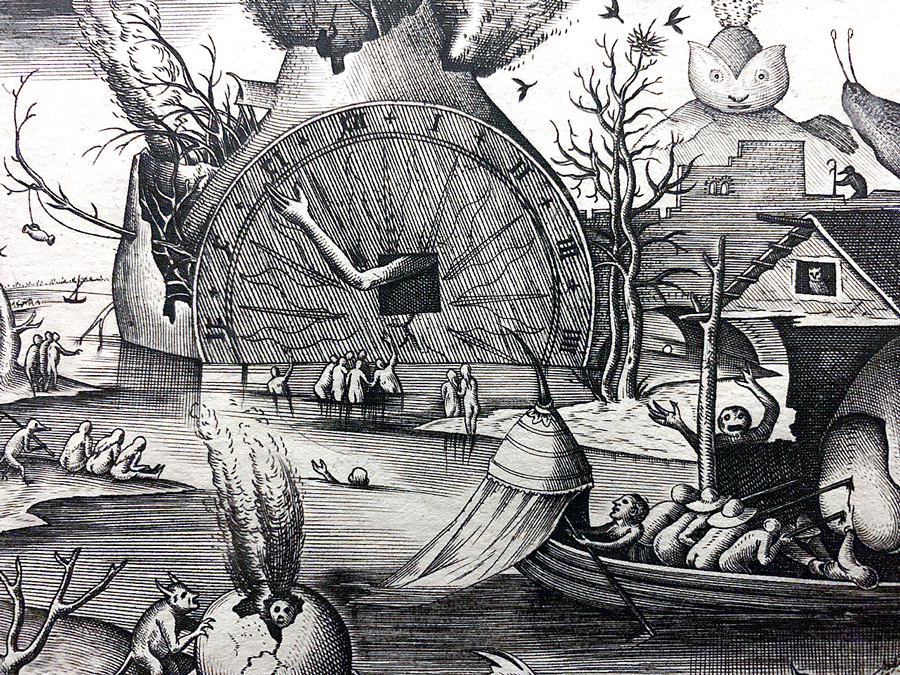We become what we behold. We shape our tools and, thereafter, our tools shape us.
— John Culkin (1967) “A Schoolman’s Guide to Marshall McLuhan” (The Saturday Review)
Human creativity is often driven by lateral thinking, which according to Margaret Boden has a weakness. She posits that AI can introduce better “standards of rigor, […] suggesting detailed questions not thought of by the humanist scholar.”[1] Boden supposes that AI models can fill this gap by tapping into where nonexistent and impossible ideas lie outside human perception (i.e. in the realms of “impossibilist creativity”), assisting in the work of mapping, exploration and transformation of conceptual spaces (METCS). AI researchers believe AI demonstrates recognition of “relationships and dependencies in the data that human observers may not have been aware of.”[2] They suggest that working with AI as a tool can not only save our time, but also further the efficiency of our headspace and thinking skills. All the time and mind-setting necessary to acquire expert knowledge, to train ourselves to perform tasks proficiently – these are potentially offloadable resources that can be better used elsewhere.
This is a benefit but one that is inevitably followed by other concerns. As technology advances, the need for specialised skills declines, as postulated by Hubert Dreyfus, who locates the danger in the following manner:
Skills reveal meaningful differences to us and cultivate in us a sense of responsibility to bring these out at their best. To the extent that it takes away the need for skill, technology flattens out human life.[3]
He argues that in such a technologically advanced landscape our ability to produce and identify details would diminish, eventually leading to a nondescript world. Consequently, with the absence of skills, we as humans would lose understanding of ourselves, and find it hard to aspire to a way of life. Dreyfus asserts that individuals come to become true beings through the cultivation of skills.
This framing might bring to mind the building of cathedrals prior to the Industrial Revolution, or the time before architecture and design was largely transferred from physical into digital infrastructure, before the focus shifted from the material to the virtual environment. A large historical span of Western civilisation saw building work as the continual laying of stones on top of another, one by one; this was especially true of medieval cathedrals, which exemplified the ambition to push against the gravitational limit to raise a high vaulting through flying buttresses and other means. This process contained plenty of risk, and it took a painstakingly long time to realise—construction could last for decades, sometimes over a century. Through a contemporary lens, one might see such a burdening task as almost enslaving. Yet human beings found meaning in this essence of collective activity, whether in faith, a sacred goal, or unified values. Sweden’s own St Peter’s Church in Klippan, Scania, is famous for the aesthetic excellence of its craftsmanship and bricklaying—completed so dexterously that not a single brick was broken in the church’s construction—which was a symbolic and holistic part of architect Sigurd Lewerentz’s architectural concept.

Figure 1. Sigurd Lewerentz, Interior of St Peter’s Church, Klippan.
I think most would agree it would be extreme for humanity to assume a skill-less world, as human survival itself is contingent on skills. The given meaning of such a skill-less eventuality might, however, be dissipated and converted into other forms in the rise of AI automation. As machine learning continues to dominate our lives, we are already perceiving this transition of skills in the form of an overriding focus on mathematical and statistical knowledge, with an accompanying reduction of other epistemic aspects. Dreyfus, however, was also aware that it was not feasible to reject technological growth. He proposed that the appropriate response was “to accept individual technological advances while preserving the poietic practices that resist a technological way of life.”[4] What can this possibly refer to? To examine this, let us borrow some examples in art from a time before digital computers infiltrated our being; art that inspires possibilities for transforming skills into an expression aiming to both embrace technology and preserve poiesis.
Algorithm versus the Art of Scoring
One can trace the genesis of the AI revolution back to the 1940s, when the crossed paths of neurobiology, cybernetics, and information theory laid the foundations for artificial neural networks.
Concurrently, one of the earliest cybernetic artists, John Cage – whose vast legacy had influences in electroacoustic music, art, and poetry – created Living Room Music. Produced in 1940, it was a composition score that consisted of instructions for outputting sound but at the same time departing from it. It blended music with everyday life by instructing the performer to use any household objects as instruments, and to experiment with percussion, spoken poetry and singing. Reading the score, the outcome of its performance was uncertain and unimaginable until it was in action; and when it was, each time the resulting event would vary depending on the performers’ choices of instruments and spoken sounds. The score’s openness to interpretation meant it had unlimited potential results, a common feature threading through the genre of cybernetic art.[5]
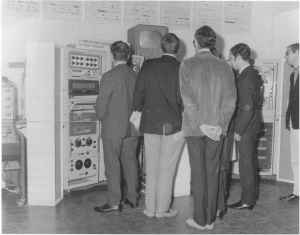
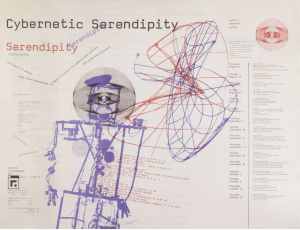
Figures 2 & 3. Cybernetic Serendipity exhibition at ICA, 1968.
Similarly, an algorithm is a type of score, an instruction. An algorithm is defined as “a step-by-step instructional procedure for transforming an input into an output independently of data (and in the fewest possible steps)”.[6] Cage’s example was also a step-by-step instructional procedure which showed that scores could be expanded from musical notations to any performable actions, amongst many other examples in the Fluxus movement, including Yoko Ono’s widely-known Grapefruit.[7] These quasi-algorithmic performance scores were often recognised and mistaken for idle poetries to be enjoyed in the mind. After the birth of computers, our ambition to write step-by-step instructions, as well as poetic lines, relocated to the domains of algorithmic and coding languages.[8] This then is now where we end up honing our skills in order to survive in today’s digital environment. Aside from lines for human beings to enjoy directly, we write detailed instructions for machines to then interpret, whether poetically or prosaically, and output the results with their filters.
But computers perform differently from analogue instructions or notated scores. Layers of algorithms and data structures are so complex that not everyone is specialised enough to craft a code from scratch, to know line-by-line how it determines particular actions, and to adjust it when necessary. Unlike Cage’s scores, machine algorithms are not open to multiple interpretations. Thus the outcome can be limited, as the limitation is intentional. The attendant fear sets in: if we continue to wire ourselves up to machine languages, we may narrow or close down – limit – our poetic expression. We may be steadily withdrawing our poetic capacities at the expense of reinforcing stubbornly rational, logical selves.
Art Form Neural Networks
A step further than computer-generated art (yet closer to the operations of neural networks) is the idea of self-generated art created from probabilistic automation, which has cropped up repeatedly since the early ‘50s. Probabilistic automation was further developed from stochastic models. Iannis Xenakis is the first known to have used stochastic processes in sonic compositions, with his orchestral work Metastaseis that premiered in 1955. The following compositions Analogique A, Analogique B, and Syrmos of 1959 were written via Markov Chains,[9] a model which Claude E. Shannon, in 1948, took to theorise as a representational model for information sources and probability measurement.[10] In musical composition, Xenakis demarcated each state space in the chain with a specific configuration of variables in registers (pitch), dynamics (volume), and the rate of activity.[11] This meant that he was delegating some decision-making to automation, creating a set of transition probabilities. Later, in 1991, as he continued to push boundaries in making fully algorithmic compositions, he created his own computer software called GENDYN that produced the piece GENDY3 in its entirety.[12] He stated that “[b]ecause of certain uncertainties introduced in the program, the composer-pilot can instil his own personality in the sonic result he obtains.”[13] In other words, GENDY3 was, to Xenakis, still a human creation rather than a machine’s.
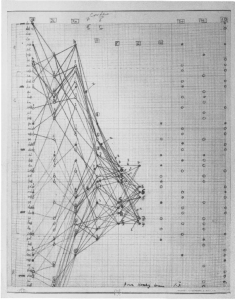
Figure 4. Iannis Xenakis, Study for Metastaseis, c.1953, resembling closely a deep neural network architecture of today that has input layer nodes, multiple hidden layers and output nodes.
Xenakis’s concepts were fundamentally driven by statistical mechanics and closely knitted with the field of information theory and processing, yet still easily comprehended without an associated background in computer sciences. Years of manual mapping and the creation of algorithms for random models, leading to his later computer-generated compositions, are recorded in his book Formalized Music: its reading is somewhat like tracing the AI via analogous means. The documentation of Xenakis’s works, ideas, and processes in Formalized Music almost discloses the basis of everything that happens after you press a shuffle button in today’s digital audio workstations: the mathematical breakdown of randomised timbre, velocity, sample selection, dynamics and so on. It is not only that programming skills are seen to be integral to the artistic concept here; knowing a technical process inside-out means artists are able to pass on the knowledge of skills and enable future generations to explore original and alternative possibilities within.
With today’s blackboxing in machine algorithms and neural networks, the more we allow transparent documentation to a mass population the better, for what is masked by algorithmic language is not immediately legible to and actionable by everyone. Like the sketches in Formalized Music, documentation reveals and preserves these important digestible mathematical configurations – these documentations can often be overlooked but have now proved themselves to be a significant transition between cybernetics and neural networks. The same applies to Gordon Pask’s 1971 text “A Comment, A Case History and A Plan”, documenting the mechanisms behind his analogue machines Musicolour and The Colloquy of Mobiles.[14] With the help of documentation, we can become aware of and embrace the changes technology is imposing on us. By glimpsing early studies of cybernetic art against the context of the history of computing, we can then revisit and reassess knowledge or skills lost to the overriding binary, Boolean logic – the true-or-false, if-or-else, all-or-none operation of symbolic AI.
More on the Disappearance of Skills
Documentation is unquestionably necessary to help obviate knowledge gaps caused by data obsolescence (which is inevitable and accelerating). Data obsolescence is one cause of Dreyfus’s concern about skill decline. Also known as data erosion, it refers to the gradual loss of data, or its integrity, through a natural evolution of software, resulting in data that is no longer readable or understandable.[15] Data stored on peripherals – tapes, floppy disks, CDs – is lost in incompatible formats as new devices are invented. Technology continues to advance exponentially; the amount of tools, devices and software that we can use is growing so quickly and vastly that each new release becomes a thin layer of a perpetually thickening envelopment. Usually not much time is afforded to ascertain whether a particular digital tool will be useful, universal and long-lasting enough to invest the time to master it. The threat of losing knowledge via incompatible media, along with the concomitant loss of skill sets, is becoming real and immediate – shorter and shorter cycles of usefulness in forming future skills continually reproduce partial knowledge and breed confusion.
Japanese culture has been apprehensive early enough to inspire a solution via their Ise Shrine tradition. In order to ensure skills of architecture and carpentry are passed down over generations, every structure of the shrine is demolished and reconstructed every 20 years since A.D. 690.[16] Almost counterintuitive, this process proved an effective way to ensure the legacy of skills and craftsmanship beyond merely conserving and repairing the existing building structures. Perhaps it is hard for us to imagine how the same approach can be applied to the history of computer technology – would this mean taking apart an Apple iPhone, a Harvard Mark 1 computer, or a Jacquard Loom from time to time, and rebuilding them from scratch? Despite the complexity and hassle, this would inevitably offer insights into why and how our technoculture is situated the way it is today. In addition, given that our reality is becoming increasingly nested in a virtual system, exploring any existing ways of preserving intangible heritage would perhaps shed some light on the future of skills.
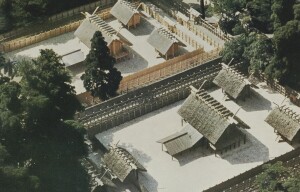
Figure 5. Aerial view of Ise Shrine
Rule-Following, Rule-Breaking
The spirit of Shuhari (“to keep, to fall, to break away”) can help us understand the value of mastering a skill and encourage such practice in the future. It suggests that one cannot truly break away and transcend the rules before “retaining” and “failing”. Documentation including records of mistakes and errors is equally useful in this aspect. Knowing which mistakes to keep constitutes true art and creativity.[17] Software engineers and computer scientists are keen to show and publish only successful results. This is where artists can occupy an opening role, revealing works-in-progress and unfiltered materials of documentation, especially when the outcomes of experiments contain errors and flaws.
An example of how an artist documents and plays with machine mistakes is Janelle Shane’s blog called AI Weirdness,[18] recording and archiving things she has found absurd in AI.[19] If creativity is partly about senselessness and bad design on purpose, then theoretically there should be a lot of room for creativity at a moment when AI is perceived to be making plenty of mistakes. In practice, this is perhaps an interesting contradiction – machines are programmed to follow instructions, therefore all mistakes that machines make are not made by breaking but by following the rules.
The implication of all these discussions is that in the face of artificial intelligence, artists will need to up their game to master computational knowledge in order to create with its tools and produce art that reflects the authenticity of the time, embracing techne with an aesthetic of poiesis; continuing (for example) the spirit of Cage, Xenakis and Pask’s experimental work and contemplating the world beyond cybernetics. Furthermore, in order to dwell upon and occupy the future where humans and AI can be co-creative by making mistakes together, one possibility is to go deeper into the mathematical rules that drive programming language and expose the existing paradoxes of rationality, such as paradoxes in set theory and statistics. Perhaps one can be enlightened by revisiting, for example, Bertrand’s probability paradox (1889) which introduces mathematical methods to generate indefinite outputs; and Russell’s paradox (1901) which has the capacity to ignite ideas beyond scientific and logical reasoning. From there, I imagine, we can discover the poetic register again and cultivate a future history of skills.
–
List of Illustrations
1. St Peter’s Church, Klippan (Swedish Centre for Architecture and Design ARKM.1973-103-070-565)
2. “Cybernetic Serendipity” Installation view, Institute for Contemporary Art, London, 1968, Hyman Kreitman Research Centre, TGA 955/18/2/2 (Tate, London, 2008, provided by the ICA and Tate Archive)
3. Franciszka Themerson, exhibition poster for “Cybernetic Serendipity”, 1968. Hyman Kreitman Research Centre, TAP 1334. (Reichardt, 1968; Tate, London, 2008, provided by the ICA and Tate Archive)
4. Study for Metastaseis (Xenakis, c.1953; The Drawing Center 2011)
5. The Rites of Renewal at Ise (Felicia G. Bock. 1974)
Notes
[1] Margaret Boden, The Creative Mind: Myth and Mechanisms, 2nd edition (London and New York: Routledge, 2004), p.269.
[2] Ali Nikrang in the documentary ‘What Happens When Artificial Intelligence and Human Creativity meet?’, directed by Massimo Leonardi, NAKED AI, November 2020 <https://naked-ai.com/> [accessed 19th May 2022].
[3] Hubert Dreyfus and Sean Dorrance Kelly, All Things Shining: Reading The Western Classics to Find Meaning in a Secular Age (New York: Free Press, 2011), pp. 190-223.
[4] Ibid.
[5] See more about cybernetic art via “Cybernetic Serendipity” at ICA London 1968, exhibited intermedia works by artists, composers and poets to celebrate the relationship between technology and creativity. It showed the overview in artists’ perspective of the context of cybernetic devices.
[6] Matteo Pasquinelli, ‘From Algorism To Algorithm: A Brief History Of Calculation From The Middle Ages To The Present Day’, Electra, n.15 “The Numbers”, Winter 2021-22.
[7] See Ken Friedman, Owen Smith and Lauren Sawchyn, The Fluxus Performance Workbook, A Performance Research e-publication, 2002 <http://www.performance-research.net/pages/e-publications.html> [accessed 1st March 2020].
[8] Hébert, who co-founded the ‘Algorist Manifesto’ with Roman Verostko, elaborated about algorithmic art: “The detailed instruction directing a drawing machine on how to draw a visual form is also an algorithm. Today, more broadly, a composer’s score for musical form and a choreographer’s notations for dance may also be viewed as algorithms. Such notations, similar to computer software formats, are detailed procedures for carrying out a task. From this perspective we could also view the recipe for baking a cake as an algorithm.” Jean-Pierre Hébert, ‘Algorist Manifesto’, 1995 <http://www.algorists.org/algorist.html> [accessed 30th April 2022]
[9] A Markov Chain is “a chain of states, each determined by the outcome of a random incident (given the range of states is fixed and each state is conditioned by the outcome of its predecessor)”, first published in 1905. Charles Ames, “The Markov Process as a Compositional Model: A Survey and Tutorial”. Leonardo, Vol. 22, No. 2 (1989), pp. 175-187.
[10] Claude E. Shannon, A Mathematical Theory of Communication. Reprinted with corrections from The Bell System Technical Journal, Vol. 27, pp. 379–423, 623–656, July, October, 1948. Shannon took literature as an example to demonstrate how Markov Chain could generate sensible-looking textual expressions, igniting the possibilities of structuring syntaxes via stochastic models and pattern recognition.
[11] See Iannis Xenakis, “Markovian Stochastic Music-Theory” and “Markovian Stochastic Music-Applications”, in Formalized Music: Thought and Mathematics in Composition, Reprint Edition (Sheffield, MA: Pendragon Press, 1992), pp. 43-110.
[12] Marie-Hélène Serra, “Composition and Stochastic Timbre: GENDY3 by Iannis Xenakis”, Perspectives of New Music, Winter, 1993, Vol. 31, No. 1 (Winter, 1993), pp. 236- 257 [accessed 30th December 2021]. GENDYN was the name Xenakis gave to his computer program(s) realizing the stochastic synthesis, short for the French term “GENeration DY-Namique”. The original program was written in BASIC by the composer himself at CEMAMu, Paris (“Centre d’ ?etudes de Mathématique et Automatique Musicales”) with the assistance of Marie-Hélène Serra. In 1991, a single run of this program called “GENDY301”, generated GENDY3, a piece of about 20 minutes.
[13] Xenakis, p.144.
[14] See Gordon Pask, 1971 “A comment, a case history and a plan” in Cybernetics, Art and Ideas, edited by Jasia Reichardt (Greenwich, Connecticut: New York Graphic Society, 1971).
[15] Remco Verhoef, ‘Data Erosion: obsolescence through development’, Medium, 20th February 2017. <https://medium.com/@remco_verhoef/data-erosion-obsolescence-through-development-30395fe2fd1e> [accessed 19th May 2022]
[16] Rachel Nuwer, ‘This Japanese Shrine Has Been Torn Down And Rebuilt Every 20 Years for the Past Millennium’, Smithsonian Magazine, 4th October, 2013.
[17] Scott Adams once said “Creativity is allowing yourself to make mistakes. Art is knowing which ones to keep.”
[18] https://aiweirdness.com/
[19] There are more curious failures of AI logged in her book You Look Like a Thing and I Love You: How Artificial Intelligence Works and Why It’s Making the World a Weirder Place, which serves a good starting point for artists to tackle the behaviour of this giant mysterious neural network.
